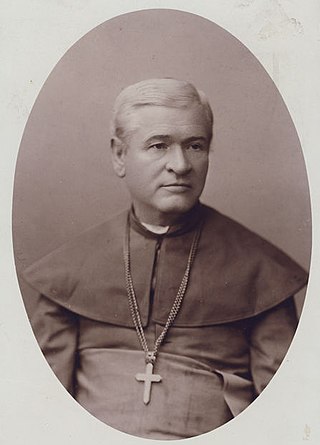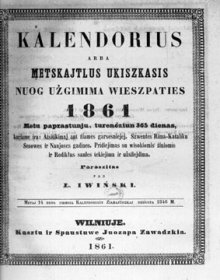
Rasos Cemetery is the oldest and most famous cemetery in the city of Vilnius, Lithuania. It is named after the Rasos district where it is located. It is separated into two parts, the old and the new cemeteries, by a narrow Sukilėliai Street. The total area is 10.8 ha. Since 1990 new burials are allowed only to family graves.

Martynas Mažvydas was a Protestant author who edited the first printed book in the Lithuanian language.

Antanas Baranauskas was a Lithuanian poet, mathematician and Catholic bishop of Sejny. Baranauskas is best known as the author of the Lithuanian poem Anykščių šilelis. He used various pseudonyms, including A.B., Bangputys, Jurksztas Smalaūsis, Jurkštas Smalaūsis, and Baronas. He also wrote poetry in Polish.

Rietavas is a town in Lithuania on the Jūra River. According to the 2001 census it had a population of 3,979. It is the capital of Rietavas municipality.

Žemaitė was the pen name of Julija Beniuševičiūtė-Žymantienė. She was a Lithuanian/Samogitian writer, democrat and educator. Born to impoverished gentry, she became one of the major participants in the Lithuanian National Revival. She wrote about peasant life in the style best described as realism.

Lithuanian literature concerns the art of written works created by Lithuanians throughout their history.

Simonas Daukantas was a Lithuanian/Samogitian historian, writer, and ethnographer. One of the pioneers of the Lithuanian National Revival, he is credited as the author of the first book on the history of Lithuania written in the Lithuanian language. Only a few of his works were published during his lifetime and he died in obscurity. However, his works were rediscovered during the later stages of the National Revival. His views reflected the three major trends of the 19th century: romanticism, nationalism, and liberalism.

The Lithuanian press ban was a ban on all Lithuanian language publications printed in the Latin alphabet in force from 1865 to 1904 within the Russian Empire, which controlled Lithuania proper at the time. Lithuanian-language publications that used Cyrillic were allowed and even encouraged.

Karolina Proniewska or Karolina Praniauskaitė (1828–1859) was a romantic Polish-Lithuanian poet and translator, of Samogitian extraction. Born in Samogitia, a historical region of Lithuania, then part of the Russian Empire, she is sometimes referred to as a Samogitian Bard.

Antanas Juška was a Lithuanian Roman Catholic priest known for his lifelong study of Lithuanian folk traditions. For about three decades, he observed the Lithuanian people, their traditions, and recorded their songs and vocabulary. Juška recorded about 7,000 Lithuanian folk songs, including about 2,000 songs with melodies, and wrote a 70,000-word Lithuanian–Polish dictionary. These works provide a wealth of information of the 19th-century Lithuanian life. His works were partially published with the help of his elder brother Jonas Juška.
Laurynas is a Lithuanian masculine given name and may refer to:

Renavas manor is a former residential manor in Renavas village, Lithuania on the bank of Varduva river. Currently it is a museum. In the manor's park grows the thickest fir in Lithuania. The manor is valued for its original interior. Renavas Manor is one of the main tourist attractions in Mažeikiai District Municipality.

The Simple Words of Catechism by Martynas Mažvydas is the first printed book in the Lithuanian language. It was printed on 8 January 1547 by Hans Weinreich in Königsberg. The 79-page book followed the teachings of Martin Luther but reflects both religious and secular needs. The book included the first Lithuanian-language poem, primer with alphabet, basic catechism, and 11 religious hymns with sheet music. The book was written in the Samogitian dialect and printed in Gothic (schwabacher) font; Latin dedication and preface are printed in Latin font (antiqua).

The Catechism, or Education Obligatory to Every Christian of Mikalojus Daukša was the first Lithuanian-language book printed in the Grand Duchy of Lithuania. It was published by the press of Vilnius Jesuit Academy in 1595 with financial support of Bishop Merkelis Giedraitis. The catechism is not an original work but a translation. As such, the work holds little value in terms of content, but is extremely valuable to the study of the Lithuanian language due to its lexical richness. The sole surviving copy is kept at Vilnius University Library.
Dionizas Poška was a Lithuanian poet, historian and lexicographer sometimes described also as Polish-Lithuanian He contributed to the early 19th-century Samogitian Revival, the early stage of the Lithuanian National Revival. Born to a family of petty Samogitian nobility, Poška attended Kražiai College. From 1786–1821, with some breaks, Poška worked as a lawyer, regent, clerk in the courts of Raseiniai. From 1790, he lived in the purchased Barzdžiai manor.

The Józef Zawadzki printing shop was a family-owned printing shop operating in Vilnius from 1805 to 1939. It was established by Józef Zawadzki who took over the failing printing press of Vilnius University established in 1575. It was one of the largest and most prominent printing presses in Vilnius. Until 1828, it had the exclusive rights to publish university publications. It published numerous books and periodicals in Polish, Latin, Lithuanian. It suffered difficulties due to Russification policies that closed Vilnius University in 1832 and banned Lithuanian press in 1864, but recovered after the restrictions were lifted due to the Russian Revolution of 1905. After World War I, it had difficulty competing with the larger printing presses in Poland. The press was sold to a Lithuanian company Spindulys in 1939 and nationalized by the Lithuanian Soviet Socialist Republic in 1940. After World War II, the press was transferred to the communist daily Tiesa.
Kajetonas Rokas Nezabitauskis-Zabitis was a Lithuanian patriot promoting the use of the Lithuanian language during the early stages of the Lithuanian National Revival. He was the half-brother of the priest Kiprijonas Nezabitauskis. After law studies at Vilnius University, he moved to Warsaw where he worked at the state censorship office until retirement in 1857. His main work is a Lithuanian primer published in 1824. It was the first illustrated primer as well as the first to include Lithuanian proverbs. It was accompanied by the first Lithuanian bibliography – a list of 73 Lithuanian-language books and manuscripts between 1557 and 1824. He edited the Polish calendar Kalendarz powszechny in 1835–1850.

Michał Olszewski was a Lithuanian Roman Catholic priest and a member of the Canons Regular of the Penitence of the Blessed Martyrs from the Grand Duchy of Lithuania. In 1753, he published a Lithuanian language collection of religious readings Broma atwerta ing wiecznastį... which became very popular and over the next hundred years was reprinted at least sixteen more times. Despite its popularity, Broma was criticized both for its naive content and impure language full of loanwords and barbarisms.

Jonas Juška was a Lithuanian teacher and linguist. He studied the Lithuanian language and worked on publishing works by his brother the Catholic priest Antanas Juška.

Graf Vladimir Zubov was a liberal nobleman from the Russian Zubov family who supported the Lithuanian National Revival.
















